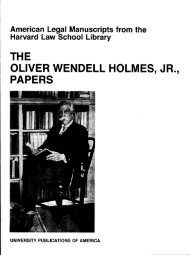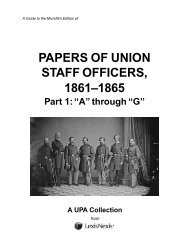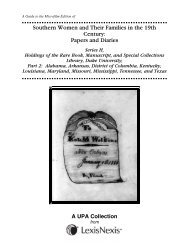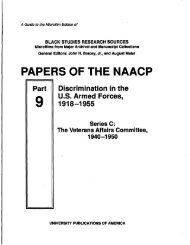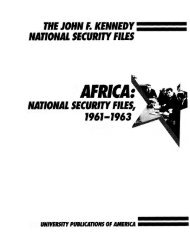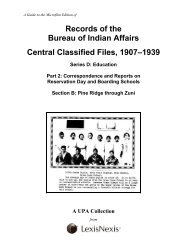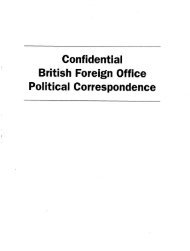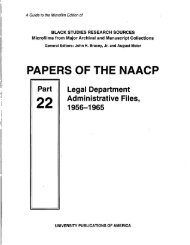guide - ProQuest
guide - ProQuest
guide - ProQuest
Create successful ePaper yourself
Turn your PDF publications into a flip-book with our unique Google optimized e-Paper software.
cil (NSC). With Nixon's strong encouragement, Henry Kiss-<br />
inger transformed the NSC system into a personal foreign<br />
policy secretariat within the White House. As head of the<br />
reformed and revitalized NSC, Kissinger occupied the "super-<br />
official" position of assistant to the President for national<br />
security affairs, with more powers than those who, since<br />
Eisenhower's presidency, had served as special assistants for<br />
national security affairs. Ultimately, Kissinger chaired six<br />
special committees operating just below the NSC level, in-<br />
cluding the controversial Committee of 40, which oversaw all<br />
covert CIA activity abroad.<br />
The reorganized NSC also created a conceptual framework<br />
for formulating U.S. foreign policy by establishing a series of<br />
National Security Study Memoranda (NSSMs). These were<br />
drafted by NSC staff and signed by Nixon or by Kissinger on<br />
behalf of the President. The NSSMs directed various agencies<br />
and interdepartmental groups within the government to prepare<br />
detailed policy or "area" options, not policy recommendations,<br />
which were then passed on by Kissinger to members of the<br />
National Security Council, who sometimes argued over them<br />
in Nixon's presence. However, since these "formal options"<br />
were written, Nixon did not always need them orally debated<br />
by the NSC.<br />
Nixon seems to have relied most heavily on these NSSMs<br />
in his first two years in office and less so in subsequent years.<br />
The NSSM system was designed to prevent the State Depart-<br />
ment and other executive departments from becoming ad-<br />
vocates of particular policies by relegating them to the roles<br />
of analysts rather than policymakers. According to political<br />
scientist Alexander George, this "Nixinger" system for for-<br />
mulating foreign policy became the "most centralized and<br />
highly structured model yet employed by any American Presi-<br />
dent." It is this system with minor variations that is still<br />
operative almost twenty years after its creation.<br />
It is sometimes said that, when Nixon created the Urban<br />
Affairs Council (UAC) with its colorful executive secretary<br />
Patrick Moynihan, this made Moynihan the Henry Kissinger<br />
of domestic policy, because the UAC was presumably based<br />
on the emerging NSC model. Such a comparison has proven<br />
misleading for a number of reasons, not the least of which<br />
was Moynihan's lack of attention to management skills. More-<br />
over, Moynihan's presence in the White House was always more<br />
tenuous than Kissinger's, not only because he was a Democrat,<br />
but also because Nixon had appointed as counselor to the Presi-<br />
viii Nixon Papers, Part 5. H. R. Haldeman Notes<br />
dent for domestic affairs, Arthur Bums, whose views opposed<br />
and often neutralized those of the head of the UAC.<br />
Despite the lack of centralization that characterized the struc-<br />
ture for formulating foreign policy, Nixon's first administra-<br />
tion actively pursued five areas of domestic reform: welfare,<br />
civil rights, economic and environmental policy, and<br />
reorganization of the federal government. In all these areas,<br />
even though his welfare reform failed to pass Congress, Nix-<br />
on's positive domestic programs may be remembered longer<br />
than his currently better known foreign policy activities,<br />
because fewer of them have been dismantled or neglected by<br />
his successors in the White House.<br />
Obviously, the domestic record of Richard Milhous Nixon<br />
will forever remain tarnished by a negative series of events, in-<br />
cluding wiretaps, the creation of the "plumbers" unit within<br />
the White House to plug information leaks and ultimately to<br />
conduct break-ins, the harassment of individuals on an<br />
"enemies" list, the misuse of the CIA to infiltrate and in-<br />
vestigate a variety of protest organizations, and temporary con-<br />
sideration given to the "Houston Plan," which would have<br />
institutionalized surveillance of suspect groups and individuals.<br />
These events climaxed with the Watergate break-ins in May<br />
and June 1972 and the subsequent attempts by the President<br />
and his closest aides to cover up these and other illegal acts.<br />
While Watergate was probably an accident waiting to hap-<br />
pen, given the "hardball" nature of U.S. politics by 1972, this<br />
does not excuse the break-ins or the cover-up that resulted in<br />
a President of the United States resigning before he could be<br />
impeached for obstructing justice. However, if historians or<br />
other students of the American presidency continue to insist<br />
that Richard Nixon was an aberration, rather than an all too<br />
common product of the American political system, as a peo-<br />
ple we will have learned little from Watergate. It is time to re-<br />
evaluate, rather than simply rehash the positive as well as the<br />
negative lessons from the administration of the thirty-seventh<br />
President of the United States. This microfiche edition of the<br />
first papers released from the Nixon White House Central Files<br />
makes such a scholarly réévaluation possible outside the<br />
facihties of the National Archives in Washington, D.C., and<br />
Alexandria, Virginia.<br />
Joan Hoff-Wilson<br />
Professor of History<br />
Indiana University



